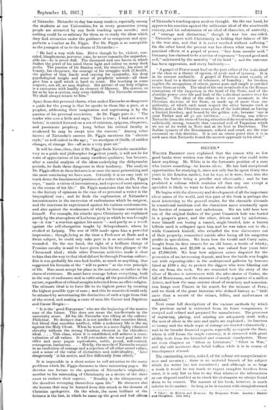SILVER.
WALTER BAGEUOT once explained tlmt the reason why no few good books were written was that so few people who could write knew anything. Mr. White is in the fortunate position of a man who knows something—he knows silver. lie has had exceptional opportunities for studying it, since not only has he spent thirty-two years in the London market, but he seas, as it were, born into the trade, his father being a jeweller and silversmith ; and he has produced a volume which contains all that any one except a specialist is likely to want to know about the subject.
He begins with the discovery and development of all the important silver mines of the world, and this part of the book is perhaps the most interesting to the general reader, for the chronicle abounds in sensational incidents and the characters move constantly upon the borders of romance mid melodrama. We are told here how one of the original finders of the great Comstock lode was buried in a pauper's grave, and the other, driven mad by misfortune, wore himself out boring a tunnel, single•handed, into a barren hillside until it collapsed upon, him and he wee taken out to tile ; while Comstock himself, who swindled the true discoverers out of their property, committed suicide after hieing all his miagotten profits in speeulation. We learn how the Gould and Curry mine, bought from its first owners for an old horse, a bottle of whisky, some blankets, and $2,500 in cash, was valued four years later at $7,600,000. We hear how adjacent mines disputed for the possession of an intervening deposit, and how the battle was fought out with repeating rifles in the underground galleries by bravoes hired at £100 a day to protect the digger. who were blasting out the ore from the rook. We are reminded how the story of the silver of Mexico is interwoven with the adveatures of Cordes, the fall of Montezuma, and the massacre of nearly a quarter of a million Aztecs, and how the same sinister cloud of treachery and arammeina- tion bongo over Pizarro in his search for the treasure of Peru ; and we think of the great historian who defined history as " little more than a record of the crimes, follies, and misfortunes of mankind," Next come full descriptions of the various methods by which the precious metal is extracted from its baser companions, is assayed and refined and prepared for manufacture. The processes of engraving, plating, met minting aro adequately dealt with ; the area of silver in the arts and crafts arc explained ; its function an money and the whole topic of coinage are treated exhauatively ; mid in its broader financial aspecta, especially ax regards the East, where it still forms the staple currency, it is dammed with groat ability both from the historical and economic standpoint". There are even chapters on " Silver in Literature," " Silver in War," and the' odd accidents that befall bullion while it is in course of transhipment abroad.
The outstanding merits, indeed, of the volume aro comprehensive. ness and accuracy ; there is no material branch of his subject which the writer has not considered ; and although in no largo a work it would be too much to expect complete freedom from error, it is only fair to him to say that wherever the information at our disposal enabled us to cheek his etatementa wo always found them to bo correct. The manner of his book, however, is much inferior to its matter. So long as he is content with straightforward aLsbtfrgigouns ifgt:r y.473 The... By Benjamin Mao. London: lloddec
exposition, his style is clear, readable, and unpretentious. But when he wishes to enforce useful moral Imams, or capture our imagination by daring attempts at the picturesque, his enthusiasm leads him astray, and he takes up an attitude of virgin and exuberant sensibility quite out of place in what is evidently intended to be
standard ereatise. Some of the illustrations, also, seem to have been chosen for reasons other than their immediate relevancy to the text ; it is stretching the principle of association rather too far to include a photograph of the Lusitania ' just because she occasionally carried silver. Apart from such minor blemishes as these, which, after all, are rather of excess than defect and do not, militate against tile central purpose said value of the book, it is systematic and thorough in its execution ; and wo have little doubt that it will fulfil the hope modestly expressed by its author that it might find its way into schools, either as a prize or a text- book, and " impart useful knowledge to a succeeding generation."



























 Previous page
Previous page